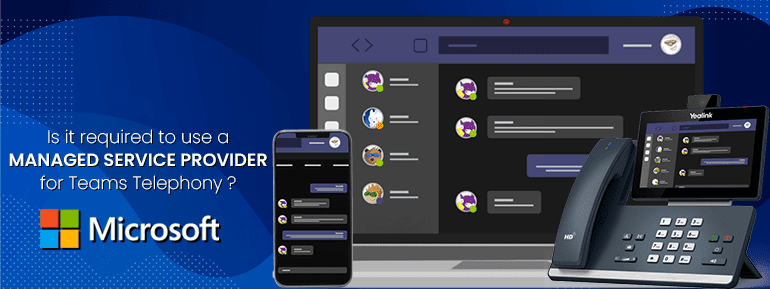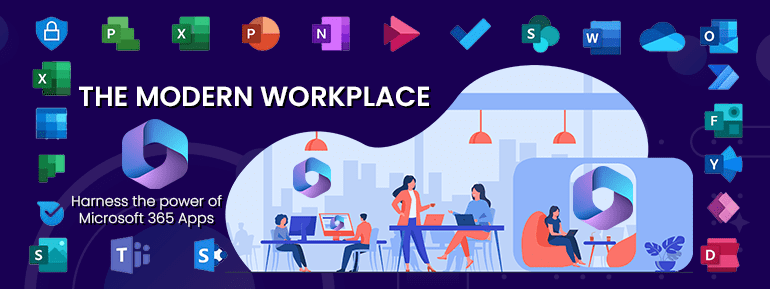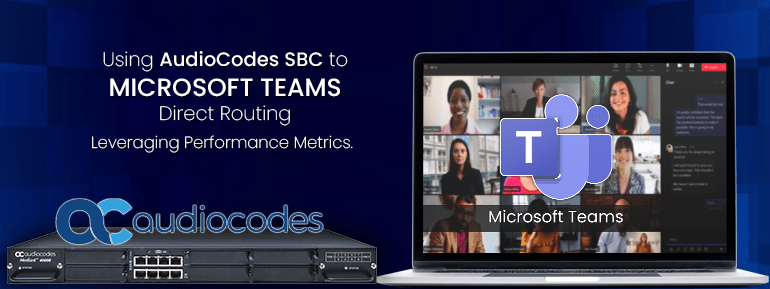With the addition of Teams Calling, a cloud-based phone service, more and more companies are using Microsoft Teams to do more. Most large businesses need to use Direct Routing to make and receive calls from the Microsoft Teams app in order for cloud telephony to work for them. When setting up Microsoft Teams cloud telephony, one of the most important things for a business to consider is whether to use a Managed Service Provider for Direct Routing or do it in-house.
Microsoft Teams has transformed how office employees communicate and work together. It enhances by making instant messaging, video conferencing, and file sharing the norm. Teams Calling, the phone feature of Microsoft Teams, is being used by more and more businesses to give their employees a single set of easy tools.
Organisations need to determine the best way to add telephony to Teams based on their business needs. Microsoft Calling Plans is an off-the-shelf solution for connecting to the PSTN for businesses with less than 100 employees. Larger organisations, on the other hand, need Direct Routing to connect to a runner managed service provider.
What is Direct Routing?
Direct Routing refers to the ability of an organisation to use its own SIP trunks or PSTN gateways to connect to Microsoft Teams. This allows organisations to use their existing telephony infrastructure with the Teams platform rather than using Teams’ built-in phone system functionality. This allows organisations to use their own numbering plans, call routing and other features while still taking advantage of Teams’ collaboration and communication capabilities.
Which is preferable for Direct Routing deployment: in-house or outsourcing to a managed service provider?
Implementing Direct Routing can be done either internally or with the help of a managed service provider.
Suppose an organisation chooses to implement Direct Routing internally. In that case, it will need the necessary resources and expertise to set up and maintain the necessary hardware and software. This includes configuring the SBCs (Session Border Controllers), configuring the PSTN gateways, and integrating them with Teams. Organisations will also need to handle the on-going maintenance and troubleshooting of the system.
On the other hand, if an organisation chooses to work with a managed service provider, it will be able to leverage the provider’s expertise and resources to set up and maintain the Direct Routing solution. A managed service provider will typically handle the procurement, configuration, and maintenance of the necessary hardware and software and provide on-going monitoring and support.
It is also worth noting that managed service providers may offer additional services such as call recording, call analytics, and disaster recovery.
You are free to pick to:
Manage Direct Routing on your own: You can host important connections, such as SBC gateways and PBX connections, in one of two ways: 1) on-site, at your business, with physical equipment, or 2) virtually, in the cloud
Employing a proficient managed service provider: (Reached a Direct Routing as a Service or DRaaS)
1. What goes into self-managed Direct Routing?
Organisations that self-manage Direct Routing is responsible for connecting to and from Microsoft’s virtual Teams phone system. This includes the following:
- Planning and building of a system
- Implementation and Establishment
- Tuning and servicing of the system
- Problem solving and regular professional assistance
- Keeping your internet and PSTN connectivity in working order
- Keeping tabs on the network
- You will also be in charge of several third parties who help you deliver your service.
- Provider of cloud hosting
- PSTN carriers in several different places
- Microsoft
- Your ISP
Self-management of Direct Routing is possible either on the organisation’s premises or in the cloud.
a) Managed on your own – hosted on-premises.
This means that all of the hardware needed for Teams Calling will need to be hosted and managed in-house.
Key duties include:
System design and configuration is the process of building and supporting a reliable solution that gives your business the best connectivity.
Infrastructure maintenance and management: including on-site installation, service, and hardware management like SBC gateways and PBX equipment. To do this right, you’ll need a lot of space to store equipment and the knowledge to run it. Also, consider the following:
- Upfront Capex required
- Power and air-conditioning expenditures spent to operate and cool hardware
- Availability of specialty hardware and parts are available
- The necessity to remain current with licence requirements and software upgrades
- Way minimises downtime when systems need patching and during other maintenance operations
Having discussions with telecom carriers–To get PSTN connections, you’ll need to do more than manage your systems and hardware. You’ll also need to manage your relationship with telecoms carriers. Depending on how many places you have. This could mean working closely with different carriers, which can take time. Depending on where you live, some countries have rules and restrictions about how you can make calls and access emergency services. This comes with its own costs and problems.
b) Managed on your own – hosted in the cloud
Even though cloud-based hosting solutions help businesses avoid the need for physical or on-premise infrastructure, they nonetheless present their unique challenges. Although cloud hosting saves physical space, it might be more difficult to set up and manage due to the increased number of parties involved. Important tasks include:
System design and setup – You will still need to design and maintain a reliable solution that provides top-notch network access for your business.
Infrastructure setup and management – Most of your Teams Calling infrastructure must be set up and maintained in-house. This needs in-depth technical knowledge and includes developing appropriately robust access to your cloud-hosting provider.
Dealing with telecoms carriers – Since telecoms is a highly regulated industry, negotiating with carriers may be harder than it sounds. Different areas have different rules, and some are more complicated than others.
2. Employing a proficient managed service provider
Direct Routing as a Service (DRaaS) entails working with a managed service provider who’ll develop, build, and operate your system. This includes reducing the number of resources needed internally. The gold standard that we term ‘Direct Routing as a Service’ refers to an end-to-end managed service provider solution. It’s crucial to realise that not all outsourced companies provide an end-to-end managed solution, so browse to evaluate service standards.
System structure and configuration – A professional Managed service provider should work with you to develop a custom solution with a system that is designed and set up just for you. They will make sure that users move to Teams and take care of the on-going management and quality control needed to ensure that connections work. DRaaS service providers like TOS can also help with general corporate network optimisation related to the service.
Infrastructure setup and management – Your Managed Service provider should take full responsibility for end-to-end service. They facilitate Teams updates, licences, maintenance, and service availability. Also, DRaaS providers should provide tools that give you important information about your Teams Calling service. For example, Data analysis portals with dashboards that provide clear information and make adjustments like adding users simply are ideal examples.
Dealing with telecom carriers – Service providers need to have solid connections with local PSTN carriers across the globe. They should be conversant with and able to comply with the laws of any applicable jurisdictions. That’s because they can take advantage of economies of scale across their client base to provide inferior prices while still providing reliable, around-the-clock access to all of their users.
Summarisation
When deciding how to deploy Direct Routing, IT decision-makers need to look at how much it costs, how complicated it is, and how much control they have if they work with a managed service provider or do it themselves. Many businesses may find that working with a service provider is the easiest and most cost-effective way to handle all the moving parts.
We give customers full, end-to-end support for their Microsoft and other IT platform needs, from the cloud to complex solutions, 24/7*.
In fact, most IT allotments have maintained the same. So although some may afford a Managed Service provider, TOS is chosen for a more tailored service.
TOS lets you schedule a call with our experts or make a direct call at +61 3 9005 6868 to discuss all the Microsoft solutions and beyond. |














